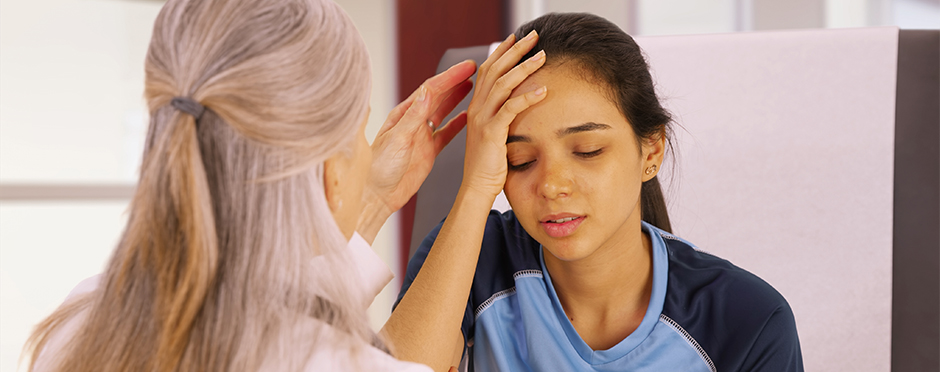
Management of Concussion in Sports
Leave a CommentIt is estimated that as many as 3,900,000 sports and activities-related concussions occur annually in the U.S. A concussion can occur from either a bump, blow, or jolt to the head or body that causes the head and brain to move rapidly back and forth, either from a fall, a collision of players, or impact from the ground or other obstacles. Collision sports are at the highest risk for concussions, but any athletic activity remains a risk.
A concussion is diagnosed by a trained medical professional using a specific set of objective tests and subjective reports of symptoms the athlete is experiencing. Concussion management requires a multi-disciplinary approach and may include but is not limited to a Physician, Athletic Trainer, Physical Therapist, school administrators, and educators, with the potential of including other medical professionals as necessary.
The latest Consensus Statement on Concussion in Sport came out in 2017, highlighting the 11 R’s of sports-related concussions.2
- Recognize: On the sidelines of a sport, an Athletic trainer may utilize a series of tests called the SCAT-5 to help assess an athlete after an injury if they suspect a concussion. If the athlete is being evaluated in a medical clinic for the first time, reaction time, a gait and balance assessment, and oculomotor screening may add to the utility of the SCAT tool.
- Remove: A player diagnosed with a sports–related concussion should not be allowed to return to play on the same day of an injury. Even if a concussion is suspected but has not been officially diagnosed, always err on the side of caution; “when in doubt, sit them out.”
- Re-evaluate: These athletes should not be left alone. It is recommended that they are assessed for any worsening of symptoms in the first few hours after injury and evaluated for any sleeping or waking disturbances. This can be done by a friend, family member, or teammate.
- Rest: After a brief period of rest during the first 24-48 hours after injury, athletes can be encouraged to become gradually and progressively more active, with the recommendation of avoiding a significant increase in their symptoms. Too much rest during this phase is shown to be associated with delayed recovery with amplified and prolonged symptoms.
- Rehabilitate: After 10-14 days, vestibular or cervical rehabilitation may be appropriate if the athlete continues to have any symptoms.
- Refer: In some instances, symptoms may persist for longer than the expected time frame and most often reflects symptoms that may be linked to coexisting factors which means it “may not be the concussion anymore.” A collaborative approach between medical professionals is the best opportunity for success.
- Recover: More research is needed to understand what it means to be fully recovered from a concussion but using your medical team’s professional recommendation, and opinion is the best course of action.
- Return to Sport: There is a 6–step process when determining the appropriateness for return to sport that should be facilitated by a doctor, physical therapist, or athletic trainer.
- Reconsider: There is ever–evolving research to reconsider how concussions are managed. Elite athletes should be treated no differently than other athletes after a sports–related concussion. Still, more research needs to be done on specific age groups, specifically in pediatric and adolescent populations compared to adults.
- Residual effects: Long-term effects of multiple concussions are still unclear, but there is not a pre-determined number of concussions that would warrant retirement from playing a sport. This should be determined by a doctor and on a case-by-case basis.
- Risk Reduction: The most promising evidence to reduce the risk of sustaining a concussion includes policy and rule changes in youth contact sports, stricter rule enforcement for head contact in sports, and waiting ten days after the most recent concussion before returning to sport. The research still does not support the topic of mouthguards and other equipment or training.
As a leader in vestibular and brain injury rehabilitation, we at Athletico can offer various services to help you recover through the complex healing process and physical challenges that can occur after a head injury. Click here to learn more about our Concussion Management Program.
*Per federal guidelines, beneficiaries of plans such as Medicare, Medicaid, Tricare, VHA and other federally funded plans are not eligible for free assessments.
The Athletico blog is an educational resource written by Athletico employees. Athletico bloggers are licensed professionals who abide by the code of ethics outlined by their respective professional associations. The content published in this blog is for informational purposes only, does not constitute medical advice and should not be relied on for making personal health decisions.
References:
1. Centers for Disease Control and Prevention, 2016
2. The Consensus Statement on Concussion in Sport- the 5th International conference on concussion in sport held in Berlin, October 2016
